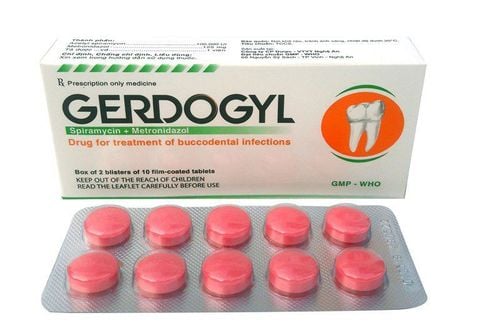This is an automatically translated article.
Flametro drug has the main active ingredient Metronidazole and other excipients in a sufficient amount. This is an antibiotic of the Nitro-5 family Imidazole has the effect of treating parasites, anti-infectives, antivirals and antifungals.
1. What is Flametro drug?
Flametro drug has the main active ingredient Metronidazole and other excipients in a sufficient amount. This is an antibiotic of the Nitro-5 family Imidazole has the effect of treating parasites, anti-infectives, antivirals and antifungals.
Flametro drug is made in the form of tablets, suitable for direct oral use. Packaging is a box of 10 blisters and each blister contains 10 pills.
1.1. Pharmacodynamics of active ingredient Metronidazole Main active ingredient Metronidazole is an antibacterial drug of the nitro-5 imidazole family.
1.2. Pharmacokinetics of the active ingredient Metronidazole Absorption: After oral administration, metronidazole is rapidly absorbed, at least 80% after 1 hour. With equivalent doses, the same serum concentrations are achieved following oral and parenteral administration. Oral bioavailability is 100% and is not affected by food. Distribution: Approximately 1 hour after oral administration of 500 mg, maximum serum concentrations average 10 mcg/mL. The mean serum half-life is 8 to 10 hours. This active substance has the ability to diffuse rapidly and strongly, with concentrations in lungs, kidneys, liver, bile, cerebrospinal fluid, saliva, semen, vaginal secretions equivalent to serum concentrations. Metronidazole active ingredient crosses the placental barrier and through breast milk. Biotransformation: The main active ingredient Metronidazole is metabolized mainly in the liver, oxidized to give 2 main metabolites: Alcohol metabolite, which is the main metabolite, has the effect of killing anaerobic bacteria. about 30% compared with metronidazole), half-life: 11 hours. Acid metabolite, about 5% bactericidal effect compared to metronidazole. Excretion: High concentrations in liver and bile, low in colon. This active substance is rarely excreted in the feces. Excretion is mainly in the urine because metronidazole and its oxidised metabolites are present in the urine from 35 to 65% of the dose. 1.3. The effect of the drug Metronidazol Pharmaceutical substance Metronidazol has good effects on both the amoeba in and outside the intestine, both acute and chronic. In the treatment of chronic intestinal amoebic dysentery, the drug has a weaker effect due to less penetration into the colon. Metronidazole drug also works well with Trichomanas vaginalis, Giardia, gram-negative anaerobic bacteria including Bacteroides, Clostridium, Helicobacter but has no effect on aerobic bacteria. The mechanism of action of the drug Metronidazole is as follows: The nitro group of metronidazole is reduced by electron transport proteins or by ferredoxin. The reduced form of metronidazole destroys the helix structure of DNA, killing bacteria and protozoa.
2. What does Flametro do?
Flametro drug is used in the treatment of diseases as follows:
Treatment of urinary tract - genital Trichomonas infections for both men and women. Treatment of Giardia lambia and amebiasis. Treatment of mouth ulcers. Prophylactic treatment of infections caused by anaerobic bacteria. Prophylactic treatment after gastrointestinal surgery and gynecological surgery.
3. Usage and dosage of Flametro
3.1. Usage of Flametro drug Flametro drug is prepared in the form of tablets, suitable for oral use. The time to take the medicine is to take it during or after a meal with a little water. 3.2. Dosage of Flametro Drug Dosage for treatment of anaerobic infections 7 days: For adults: oral dose of 30-40 mg/kg/day, divided into 4 times; for children: 20 - 30mg/kg/day, divided into 4 times. Duration of dose used to treat intestinal amoebic dysentery is from 7 to 10 days; duration of treatment for liver amoeba is 5 days; for adults: 1.5 g - 2 g/day, divided into 4 times a day; for children: 40 - 50 mg/kg/day, divided into 4 times a day. Dosage for treatment of Trichomonas infections in the genital tract is 250mg, 3 times a day (for women and men) for 7 days, for women, it can be combined with vaginal placement. Dosage for treatment of Giardia infection is 2 g daily, divided into 4 times, the duration of treatment is 3 days.
4. Undesirable effects of the drug Flametro
In the process of using Flametro drugs rarely encounter unwanted effects. However, there have also been reported cases of adverse effects such as mild gastrointestinal disturbances: nausea, anorexia, metallic taste in the mouth, burning pain in the epigastrium, vomiting, diarrhea.
Some other undesirable effects of unknown frequency may occur when using the drug, including:
Skin and mucosal reactions: urticaria, vasomotor flushing, itching, glossitis with a burning sensation in the mouth; Neurological and psychiatric signs: headache, dizziness, confusion, convulsions; Pancreatitis, reversible upon discontinuation of treatment with this drug. Decrease in white blood cell count. Peripheral sensory neuropathy, these signs and symptoms always decrease and then completely disappear when treatment is stopped. Urine may be stained reddish brown, which is caused by pigments formed during drug metabolism.
5. Flametro drug interactions
Flametro should not be combined with the following drugs:
Disulfiram: because it can cause paranoia and psychosis. Alcohol: antabuse effect with signs including heat, redness, vomiting, heart palpitations. Caution when combining Flametro with:
Oral anticoagulants, in particular Warfarin: increased anticoagulant effect and increased risk of bleeding (caused by reduced hepatic metabolism). The treating physician will adjust the dose of anticoagulants during treatment with metronidazole-containing drugs up to 8 days after stopping treatment. Other combinations of Flametro should also be noted:
Use of Flametro with 5 Fluoro-uracil: increased toxicity of 5 Fluoro-uracil due to decreased clearance. Laboratory tests:
Active ingredient Metronidazole can immobilize spirochetes, thereby falsifying the results of Nelson's test.
6. Some notes when using Flametro
6.1. Contraindications of the drug Flametro: People with hypersensitivity or hypersensitivity to the main active ingredient Metronidazole or other ingredients in the drug. People with or have a history of epilepsy. People with blood clotting disorders. The woman is in the first 3 months of pregnancy, breastfeeding. 6.2. Other notes and precautions when using Flametro. Monitor white blood cell counts for people on high doses or long-term treatment with this drug. In case of leukopenia, continued treatment depends on the severity of the infection. Use in pregnancy: According to animal studies, metronidazole is not teratogenic and is not toxic to the fetus. Research on hundreds of pregnant women using metronidazole active ingredient during the first 3 months of pregnancy but no cases of malformations and studies using after this 3 months did not find toxicity to the embryo. Therefore, the active ingredient Metronidazole is not contraindicated in pregnant women, but patients should still use it only in case of necessity. Use of drugs for women who are breastfeeding: Avoid taking drugs containing the active ingredient Metronidazole while breastfeeding. This is because this active substance can be excreted in breast milk. Above is all information about Flametro drug, patients need to carefully read the instructions for use, consult a doctor / pharmacist before using. Absolutely do not arbitrarily buy Flametro medicine to treat diseases at home, because there may be unwanted side effects on health.
Follow Vinmec International General Hospital website to get more health, nutrition and beauty information to protect the health of yourself and your loved ones in your family.













